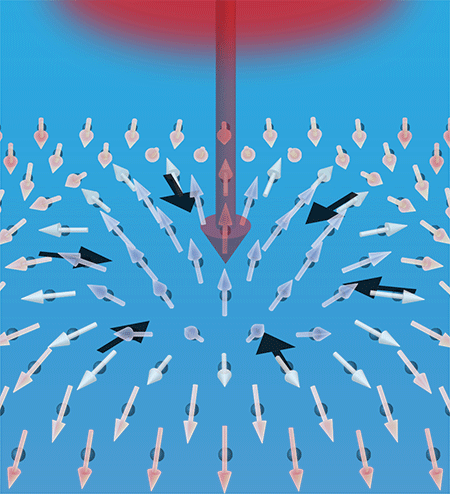By Brian Santo, contributing writer
You just mistyped “Skyrim” into Google and ended up here, didn’t you? Pull up a chair anyway. Skyrmions might not be as much fun as being Dragonborn, but they’re pretty close. It starts with their classification; skyrmions are among a set of bizarre phenomena called quasi-particles.
Quasiparticles have little in common with each other beyond having no physical existence, yet having particle-like characteristics. The list also includes bogoliubons, dropletons, phasons, rotons, and wrinklons.

A skyrmion is a point-like region of reversed magnetization in a uniform magnet. Image source: Alan Stonebraker/physics.aps.org.
Skyrmions do not exist outside of magnetic fields. A single skyrmion is a point-like region of reversed magnetization surrounded by a whirling twist of spins, according to Christopher H. Marrows, a physicist at the U.K.'s University of Leeds School of Physics and Astronomy, in the journal Physics. The phenomenon was posited in 1962 but not observed until 2009.
Impressively, skyrmions could end up being the basis for the next step in computer memory. Chip manufacturers worry that progress in semiconductor memory technology development could conceivably hit a wall in the not-too-distant future as they approach what appears to be strict limits in physics with silicon-based DRAM and flash memory. Anything that might be a viable replacement is being aggressively investigated, and skyrmion memories might be a viable replacement.
Skyrmions are only a few nanometers in size, very stable, and easily manipulated with spin-polarized currents that consume little power, which makes them potentially suitable for computer memory for nanoelectronics systems, said Marrows.
Skyrmions are not evident in many materials, however. A group of researchers from China has done some of the pioneering work in this area, including discovering a material that is skyrmion-rich at room temperature: CoFeB/MgO (cobalt-iron-boron/magnesium oxide).
They have also devised a skyrmion-based racetrack memory (RM). RMs are experimental but intriguing because they combine a set of performance traits that suggest that they could succeed over today’s DRAM and flash memory. IBM has reported success building RMs using silicon and a CMOS process (standard for silicon semiconductors).
The Chinese researchers describe the additional work necessary to make their skyrmion-based memory practical but believe it might end up a better option than silicon-based RMs. “Skyrmion-based RM (Sky-RM) is promising to achieve lower energy cost, higher device packing density, and more robust data stability,” they said in their paper.
The Chinese researchers are also exploring other potential applications, one of which they say might not be possible without a skyrmion-based device. In January, they described a skyrmion-based artificial synapse device for neuromorphic systems. They caution that they have managed only a rudimentary simulation, but they have devised a variation of an RM in which skyrmions could be induced to behave in a manner that mimics the way that synapses work.
Advertisement
Learn more about Electronic Products Magazine





